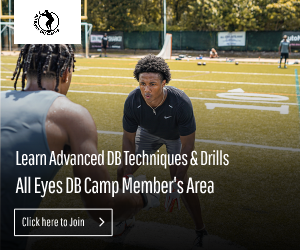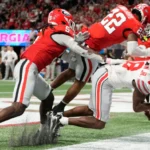We are certainly growing up in a me era. Everyone is worried about their individual well being, their status, their brand and their stats. I am not here to get political or philosophical but this attitude has swept into the biggest team sport in the World, football.
The message in this article is primarily for cornerbacks but safeties need to hear this as well. Some prominent cornerbacks have been quoted as saying “they don’t pay me to make tackles.” Those guys may have been right. You’re not those guys. Football is a team game and good defense is good when the team plays as a unit. With all of that said, it’s not ok for you as a defensive back to get blocked on a run play or screen and let the ball carrier race down the field.
With that in mind, let’s talk about some ways that we can avoid being a pillow on run plays that disappears when things get physical. Sure, I know that there are times when you are in man coverage, locking on to a receiver and there is a run play. Those are the hardest situations to become a tackler. However, because it’s hard does not mean that you don’t try. Too often I see defensive backs in that situation succumb to the block. They do this by staying engaged with the receiver making little to no attempt to separate while they watch hoping for someone else to make a tackle. That’s not how this thing works.
First of all, when you do this, the offense is getting yards rushing the ball. If that is successful, they will continue to do it. This means less balls in the air and less opportunities for you to make the kind of plays you love to make. Second, every time that receiver dominates you on a block he gains more confidence in the thought that he’s better than you.
When you are in man, running down the field with a receiver and realize that it’s a run play, your first job immediately is to separate. This means get your hands inside of his, put them in his chest and extend (that’s why we bench press in the weight room). Aside from assisting in you getting away from the receiver, it gives us a good chance at getting a holding call. Next, we must quickly determine the side of the receiver we need to be on to make the play or turn it to our help. Once we’ve done that, it’s time to work to get there. With your hands inside, tug on the side of the shoulder you need to defeat. Then step around that side and work to get beyond the receiver. From there, you should do your best to attack the ball carrier. Often times, this results in the receiver pulling a jersey and producing a holding call. That means that no matter how far the ball carrier goes beyond that point, the ball is coming back to that spot and then 10 yards back from there. That’s a big win for the defense. None of this happens if you just stay locked on to the receiver’s block and be a spectator.
When secondary members are in zone coverage, we have better opportunities to attack the ball carrier. For starters we recognize that it’s run sooner. Second, we have the advantage of seeing the ball carrier’s path while the receiver can not. With this in mind, there are two things we can do.
First, which is more tactical, we can redirect the receiver away from the area the runner is headed to. The wide out has no idea where the ball carrier is. If there is enough time and space, a cornerback can run to the inside moving the receiver and then dart back outside to get to his leverage point and make the play. This allows the corner to potentially be unblocked or close down the lane that the ball carrier has to run through. This can happen even if the cornerback eventually gets blocked. Both of those things are a win for the defense. Safeties can do this as well with caution. A quick move as the ball carrier is approaching to move the receiver can open up things to make an open field 1-on-1 tackle.
Second, we can do the more traditional thing which is quickly get to our area and force the run from that angle. When we do this, we are most certainly going to have to engage the receiver or lineman that is attempting to block us. When encountering a skill position player attempting to block us, we have a number of ways to engage and separate. We can use a rip technique, a swim technique or a push-pull method. In the video at the end of this post, I demonstrate some of these methods. They are very effective in either gaining separation or drawing a penalty.
Anyway you look at it, you need to be active on run plays as a member of the secondary. Giving up explosive run plays is a surefire way to lose a ball game and to not see very many passes from your opponent. When all 11 men on defense are committed to erasing any play that offense runs, you end up being on a great unit where everyone gets to become a star. That’s the best way to build your brand.
Chad Wilson is the owner of All Eyes DB Camp and author of "101 DB Tips". He played college football at the University of Miami and briefly in the NFL for the Seattle Seahawks. Over his 15 year high school football coaching career, he tutored over a dozen Division I defensive backs and as a trainer has worked with NFL All Pros, first round draft picks, college football All Americans and Top 10 ranked high school football prospects.






